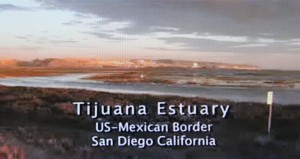The Wall: Documenting the environmental and social impact at the border
 The walls that divide Mexico and the United States, designed to contain undocumented immigration and the traffic of drugs and weapons, will also be responsible for the diminishing of one of the most important ecosystems in the Tijuana-San Diego region: the Tijuana River Estuary.
The walls that divide Mexico and the United States, designed to contain undocumented immigration and the traffic of drugs and weapons, will also be responsible for the diminishing of one of the most important ecosystems in the Tijuana-San Diego region: the Tijuana River Estuary.
This ecological disaster, that began with the construction of the second and third border fences in the southwestern border, is what motivated documentalist Greg Rainoff to shoot , a film that intends to show the American audience the tremendous environmental and social impact the border fences will have in our communities in order to preserve public safety and contain undocumented immigration.
“This is the last estuary in Southern California, all of the other ones have been severely damaged or are completely destroyed,” lamented Greg Rainoff, a long time San Diego resident.
The film begins with a beautiful panoramic view of the vegetation and wildlife of the Estuary still untouched, capturing the sounds of the birds and the waves of the Pacific Ocean. But the pretty images don’t last much and suddenly mix with the strenuous sounds of bulldozers building a forty feet high dirt wall crowned with a shiny metal fence.
”They are destroying a treasure of humanity” said Oscar Romo, an environmental scientist interviewed at the beginning of the film.
Romo explained how sediment from these man-made mountains of dirt will eventually flow down and cover the 450 acres of vegetation that serves as a lung to filter the polluted air we breathe. He also warns about the impact of the constant deforestation in the area, that helps keep the hills solid with a layer of vegetation covering it, that if damaged will take more than a hundred years to grow back.
The scientist reflects on the promise made by the Department of Homeland Security to restore vegetation after the building efforts have completed.
“I just don’t trust them… it’s not their line of work, and they don’t even have the resources to finish the border fences” said Romo, who believes that one day a federal administration will stop funding the expensive border protection program and eventually the walls will come down.
But the filmmaker is not as positive as Oscar Romo, and doesn’t believe that the walls will come down, or at least anytime soon, considering that during the next five decades Mexico will produce about five million more immigrants.
‘I fear that there will be more fences, more guns and more migra… if we want that wall to come down a lot of things will have to change between the two countries,” said Rainoff.
The contamination caused by domestic garbage and industrial waste from is one of the factors that contribute to environmental distress documented in The Wall.
During the shooting of the film Greg accompanied environmental activist Ben Macue to one of the most polluted of the Tijuana River Estuary, where they found a large amount of plastic, tires, torn out clothes and even abandoned toys that where dragged by rainwater from the colonias and industrial parks south of the border.
The bigger picture
Asides from the environmental damage, the wall examines how national security has been used to justify actions that directly impact the lives of the border residents, particularly the closing of Friendship Park, where for decades families of immigrants divided by their immigration status met through a chain linked fence.
The film documents the civilian resistance against the closing of the park held by pro immigrant activists during 2008 and 2009, including the arrest of father John Fanestil, for allegedly trespassing safety limits imposed by federal border agents during the construction of the second and third wall that now divides Friendship Park.
Before his arrest Fanestil was celebrating mass for people on both sides of the border and was trying to give communion through the gaps in the fence.
“There was no security reason why that park had to be destroyed” said Rainoff during the interview. “the Border Patrol said it was because of drugs, but there was a fence already there, how many grams of cocaine do you have to pass through that fence to make a big bag?”.
From a much broader perspective the author analyzes the whole free trade economic model that has led to the problems at the border like the migration from southerN Mexican rural areas to northercities, the terrible labor and health conditions of the maquiladora employees that build American products, and the rise in violence caused by the drug trafficking cartels.
“My taxpayer dollars are paying for the whole immigration mess, for the environmental damage, for the migra” said Rainoff, while questioning “at what cost to democracy? At what cost to our national infrastructure? At what cost to our environment?”






